Table of contents:
Overview of Anchor podcast hosting (now Spotify for Creators)
Anchor.fm vs Spotify for Podcasters vs Spotify for Creators: What Happened?
What’s new in Spotify for Creators?
Spotify for Creators: Key features
User interface: Is Spotify easy to use?
Getting started: How to start a podcast with Spotify for Creators
Should you use Anchor.fm (Now Spotify for Creators)? Pros and cons
Key takeaways:
- Anchor.fm was acquired by Spotify in 2019 and has been known as Spotify for Creators since 2024.
- The platform's key features include: hosting, analytics, monetization, and promotion.
- Pros: Spotify for Creators is free, offers a big distribution network, and integrates with Riverside for easy podcast creation from end to end.
- Cons: There isn’t much room to customize the interface and you could probably find more robust analytics on a different platform (but at a much higher cost.)
- This platform is best for beginners starting a podcast on a budget.
With nearly 700 million active users, Anchor.fm (now Spotify for Creators) is an incredibly popular podcast platform—and one you can’t afford to miss.
But what features does Anchor (or Spotify for Creators) actually include? And, who is it best for?
Keep reading! I’ll give you an overview of Spotify's key podcasting features, and its pros and cons. Plus, I’ll compare it to other hosting platforms, so you can see where it stands.
Overview of Anchor podcast hosting (now Spotify for Creators)
Anchor.fm launched in 2015 as a mobile-first "public radio" for recording and sharing audio between people. Born as a social network for voice, it has now evolved into Spotify for Creators, a hosting platform with tools for podcast advertising, scheduling, analytics, and creation.
Today, Spotify for Creators is the perfect place to start if you’re a beginner or just want to try podcasting at no cost. It’s 100% free with unlimited storage and has all the basic features you’ll need to get started.
Anchor.fm vs Spotify for Podcasters vs Spotify for Creators: What Happened?
Once a stand-alone tool, Anchor.fm was one of the top hosting software for podcasters. Nearly half of the public podcasts were hosted there.
In 2019, Spotify acquired Anchor.fm, as part of their strategy to become a one-stop shop for podcasters. In 2023, Spotify rebranded Anchor.fm as Spotify for Podcasters, and then again as Spotify for Creators in November 2024. The idea is to provide an all-encompassing creating, hosting, and promoting platform for all content creators.
What’s new in Spotify for Creators?
Spotify for Creators’ interface and user experience isn't much different from Anchor.fm, which is a good thing, since the original software was accessible and easy to use.
Spotify, however, has improved Anchor.fm by providing more granular analytics, as well as more complete data from other platforms. They provide deeper insights into your audience, but they’re still not IAB-certified, and the depth of analytics is still limited compared to paid hosting options.
Integration with Spotify's larger ecosystem also means you can tap into expanded distribution tools and monetization options, making it easier to grow your audience. Spotify also now includes an official integration with Riverside. You can record, edit, repurpose, and publish your podcast in studio quality, all in one flow. This makes Spotify for Creators an excellent tool for beginner podcasters.
Spotify for Creators: Key features
Merging the best Anchor.fm and Spotify could offer, Spotify for Creators is packed with useful tools for podcasters.
I’ve spent hours on the platform. Here’s my honest, hands-on breakdown of the core features:
Content hosting
One of the best things about Spotify is that it offers unlimited hosting space absolutely free. You won’t need to pay a third-party hosting service, which can be a huge barrier to entry for new podcasters.
You can also import all your episodes from a previous host by redirecting your feed. You'll even get to keep your followers from all platforms!
Recording & editing: Integration with Riverside
Being able to record podcasts directly from your Spotify for Creators dashboard via the integration with Riverside is a massive upgrade.
You can record remotely with up to 10 participants, capturing each person’s video and audio on a separate track. Everything is recorded locally on each participant's computer, capturing up to 4K video and 48kHz WAV audio quality. That means crisp audio and video, regardless of the quality of your internet connection.
After recording, polish your podcast using Riverside’s powerful text-based editor. Simply delete words in the automatically generated transcript, and the corresponding video will sync. Plus, Riverside offers many AI tools that make editing a breeze. For example, you can enhance audio, cut filler words and clean up long pauses.
Finish off with a background, custom layout, an automatic transcript, and AI-generated b-roll, then publish straight to Spotify. Easy!
Distribution
With nearly 700 million users in 180+ markets, tapping into Spotify’s distribution network means reaching out to one of the largest worldwide audiences. With Spotify for Creators, your show is instantly live on Spotify and can be easily submitted to other podcast networks via RSS feed.
Episode management
The platform provides valuable tools for creating and managing episodes. You can:
- Record or upload audio
- Arrange segments within an episode
- Schedule releases
- Create trailers
- Add background music from Spotify’s royalty-free library.
And, more.
These features help you streamline production so you can focus on creating great content instead of getting bogged down in technical setup.
Cross-platform compatibility
Getting your show onto Spotify is incredibly simple, and it appears almost instantly. It also generates an RSS feed to submit your show to other podcast directories like Apple Podcasts, Amazon Music, iHeartRadio, and many more. You can also add your platform listings to your Spotify for Creators profile to help listeners find you on other platforms.
Analytics

Unlike the old Anchor podcast platform, which provided only total plays, audience size, and demographics, Spotify’s podcast analytics are more detailed. The data for your Spotify listeners is especially rich and useful to understand who your audience is and what content they enjoy.
From my experience, while this data is great for refining your content strategies, I'd take the raw numbers with a grain of salt. The number of listens and downloads is often inaccurate or inconsistent. It sometimes even varies between different pages of the Spotify for Creators dashboard. Plus, these analytics aren’t IAB-certified, which means potential advertisers may not trust them.
As one user reported on Reddit:
"I've seen my episode listens drop in numbers by a few. People can't unlisten to a show!".
Spotify's analytics include data about:
- Total plays: Plays count how many listeners downloaded an episode or streamed it for 60 seconds or more. You can also see plays per episode, which shows you which shows were most successful.
- Audience retention: By understanding where audiences stopped listening, you can see where they were less engaged and got bored.
- Impressions: This refers to how many listeners were exposed to your episode on Spotify. You’ll also see where on Spotify your podcast is showing, which can help you optimize it better.
- Listener demographics: This shows your audience’s gender and age. Understanding your audience is key to producing content that’s relatable.
- Listener habits: Knowing what devices your audience listens from ensures you create compatible content. For example, if listeners are joining from their phones then they’re more likely to be listening on the go.
- Listeners’ geographic locations: Knowing where your audience is listening from informs the content you create and the best times to post episodes.
- Video analytics: Get an idea of how many viewers watch your video podcast and for how long.
Promotion
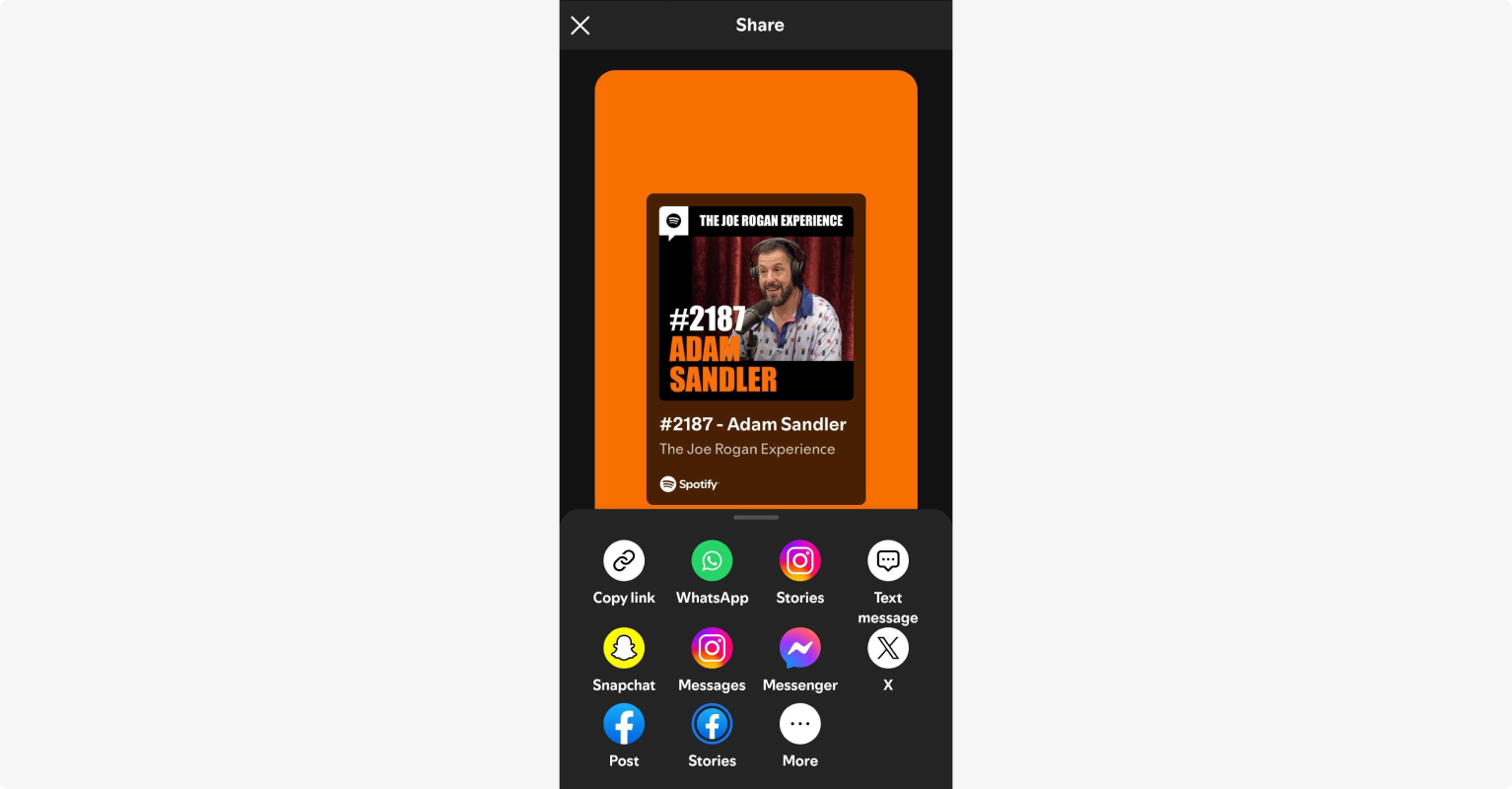
Spotify's in-app promotional features can boost your podcast's visibility and make sharing on social media much simpler. For example, you can share your podcast on Instagram, Facebook, and other social media platforms.
You can also use the integration with Riverside to let Magic Clips automatically generate shareable social media videos with a click.
Don’t forget to enhance the algorithm-driven recommendations by choosing the right keywords during your show to improve categorization.
Audience engagement
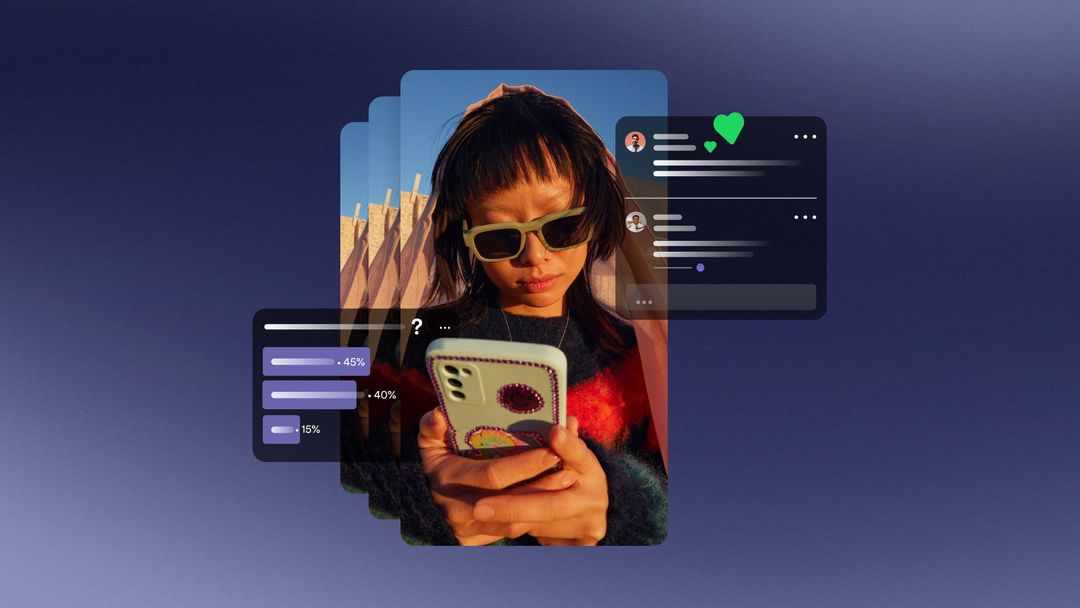
You can boost your community’s loyalty and engagement on Spotify’s mobile app with features like comments, Q&As, and polls.
You will be notified immediately once a listener leaves a comment. But, you must approve them before they become visible on Spotify. You can also like and reply to comments to spark a conversation.
Monetization
Compared to when it was Anchor.fm, Spotify for Creators offers several avenues to monetize your content, although there are some limitations worth noting.
- Automated ads: Spotify inserts ads into your episodes, and you earn a share of the revenue. However, Spotify keeps 50%, one of the steepest cuts in the industry.
- Paid subscriptions: You can offer exclusive content to paying subscribers only.
- Spotify Ads Manager: Spotify offers its own ad management platform to create your campaigns and target specific audiences.
- Donations and tips: You can receive one-time or monthly donations from your listeners directly through the platform.
Note that eligibility requirements are pretty strict. For subscriptions and listener support, you need to have at least 100 unique listeners in the past 60 days and be in one of the supported markets (primarily the U.S.and parts of Europe and Oceania). However, the pool of advertisers has grown tremendously under the Spotify brand, so it provides much more opportunity than Anchor.
If you qualify, payments are processed through Stripe, which may apply additional fees. You can find more information here.
Copyright management & ownership
Like Anchor, Spotify protects your content's copyright by upholding your intellectual property rights. But now, you also get access to a library of licensed tracks, so you can add music to your podcasts without worrying about copyright violations.
Does Anchor own your content?
To put it bluntly, no Anchor did not own your content, and neither does Spotify. You retain ownership of your podcast.
There’s a tradeoff, though. When you use the platform, you grant Spotify a very broad license to use, distribute, and create derivative works from your content for promotional purposes.
As one user on Reddit noted:
"The only negative is the fine print in their T&Cs. You give them rights to your material. If you are doing something big I would go with a paid service that doesn't do this."
User interface: Is Spotify easy to use?
Anchor's interface was known for being very minimal and basic. The new Spotify for Creators is more polished and professional, but still very easy to use, even for beginners.
Accessibility
Spotify for Creators is designed for accessibility. The interface is in black and white to ease readability. It offers features such as screen readers, adjustable text size, and multi-language support. Navigation is very simple, and you're usually just a click or two away from where you need to be.
One downside to note is that it’s clearly desktop-first. The mobile app is limited and mostly serves as a management and analytics dashboard.
Learning curve
Spotify is designed for creators and has a very gentle learning curve. Plus, you’ll find a whole range of tutorials under the Resources section designed to help you create and grow your podcast.
Because Spotify integrates with Riverside, you can record and edit right in your Spotify account. This is easy too!
Getting started: How to start a podcast with Spotify for Creators
Starting a podcast on Spotify for Creators is a very straightforward process. The process hasn’t changed much since the platform was known as Anchor.fm. Here is a quick recap of the steps you need to follow:
Step 1: Log in to your Spotify for Creators (Anchor.fm) account and proceed to the home page. If this is your first time creating a podcast, you should see this screen.
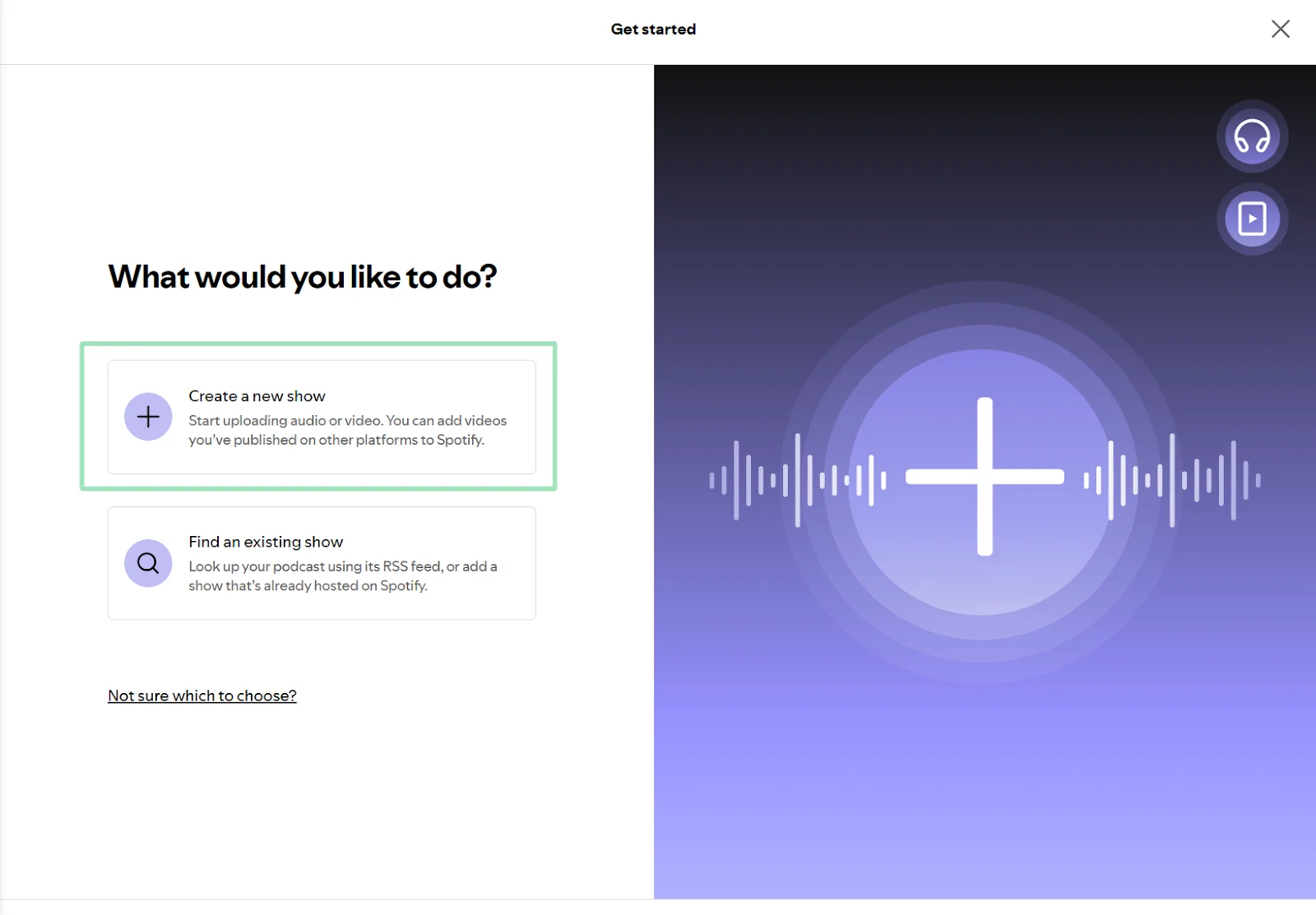
Click on “Create a new show” to create a new podcast.
Step 2: Now, you can choose whether you want to upload an existing file from your computer, or start recording a new podcast on the spot using Riverside.
If you want to upload a file, click “Select a file” to upload your file.
If you want to record a new episode, just click on the “Create with Riverside” button on the left side of the screen.
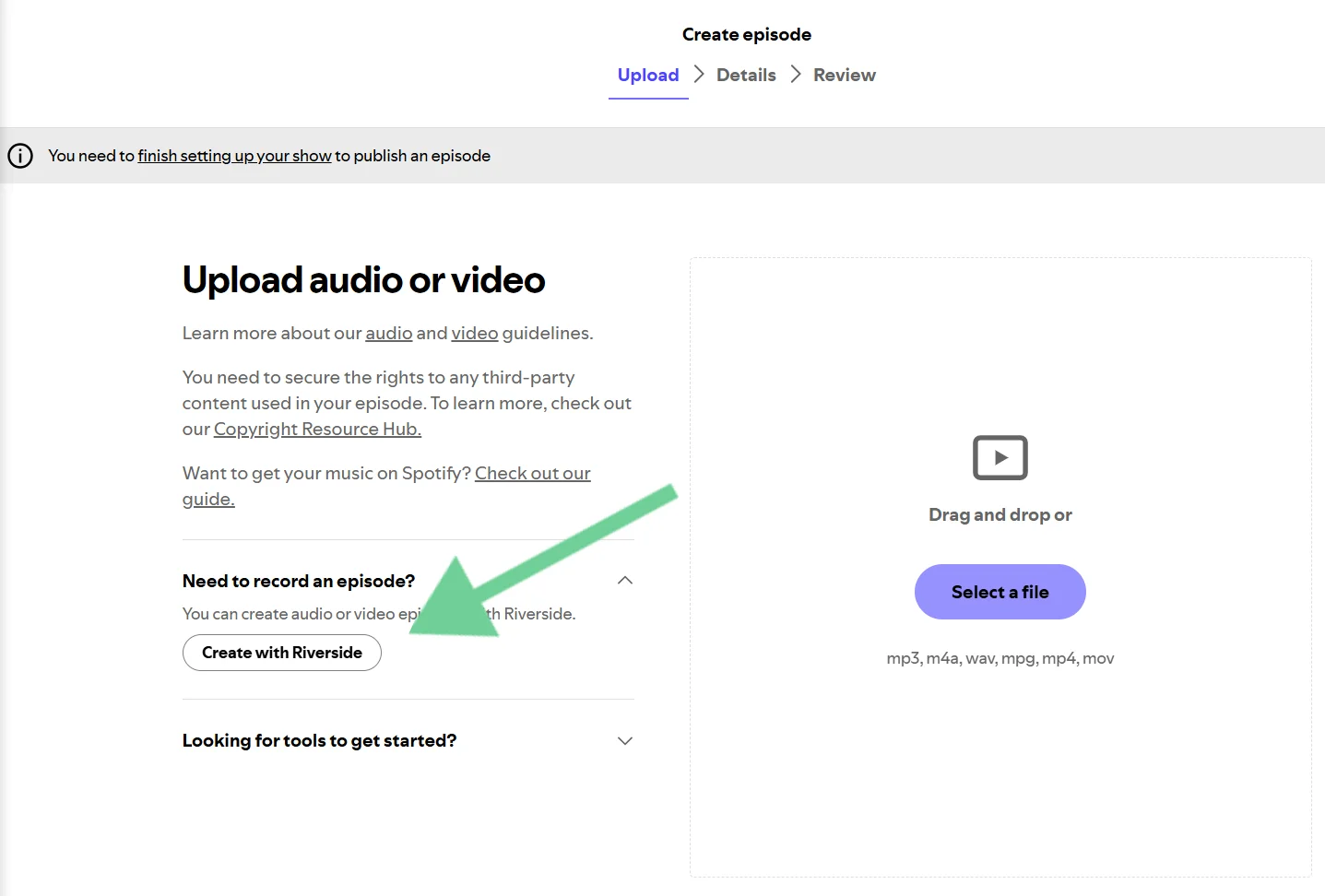
Step 3: If you choose to record a new episode with Riverside, wait for the pop-up to open, then either log in or sign up for a free Riverside account.
Now, click “Record.” Choose whether you want to record video & audio or audio only.
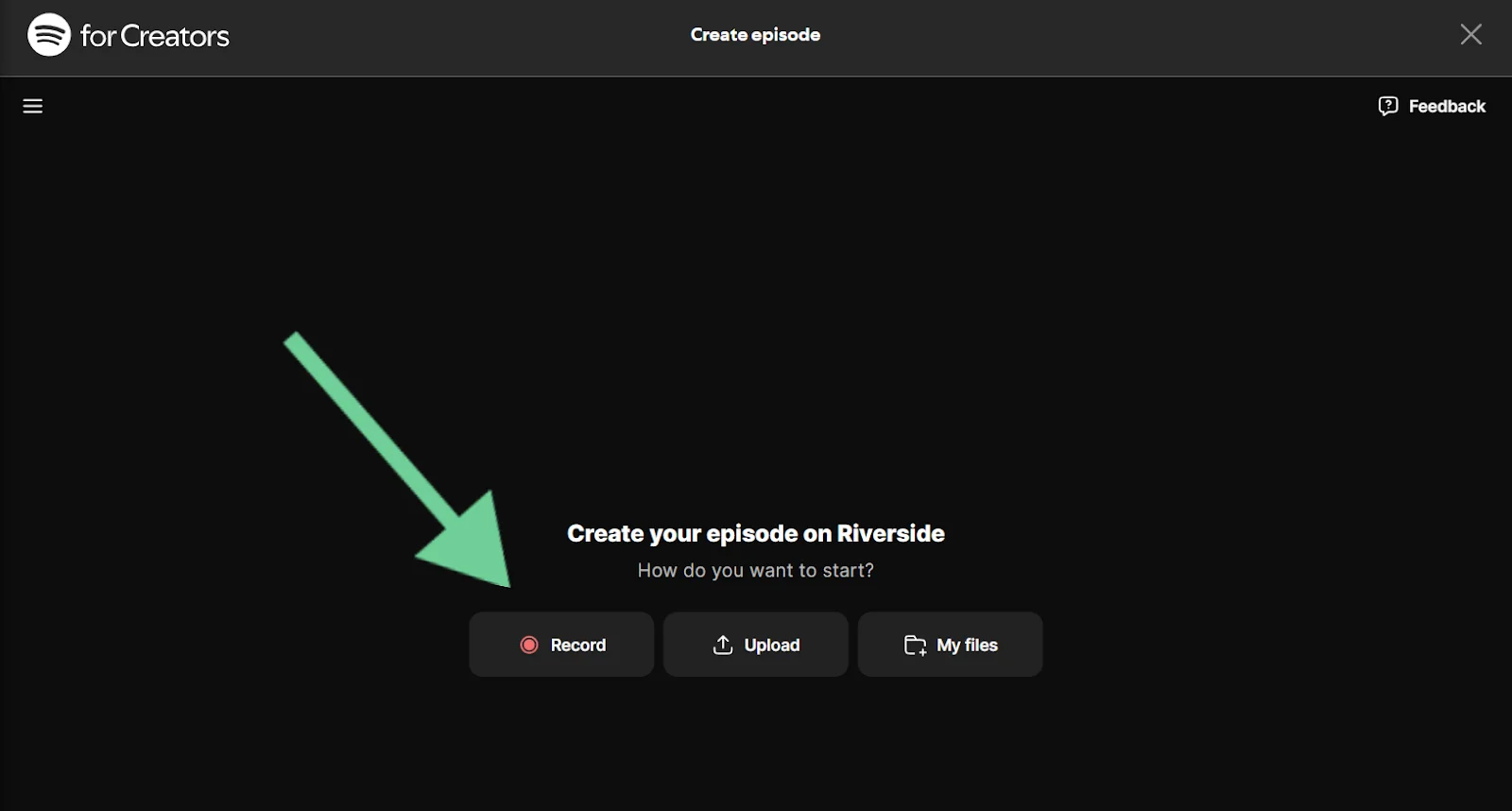
Step 4: You'll first get taken to the Lobby. Check your equipment here. When you're ready select "Join studio."
Inside your Riverside Studio, you can invite your other guests. Simply click "Invite" on the top right, then share the invite link with them.
When you're ready, click “Record” to start recording your episode.

Step 5: Once you’re done, click the stop button to end the recording. Then click on the “Go to project” button that will appear to start editing your recording.

Edit your podcast as you deem fit, and then click “Export to Spotify”.
Step 6: Fill in your episode details, such as title and description, and then choose if you want to publish your episode now or at a later time. When you’re done, click on “Next” and then on “Publish” to start your new podcast.
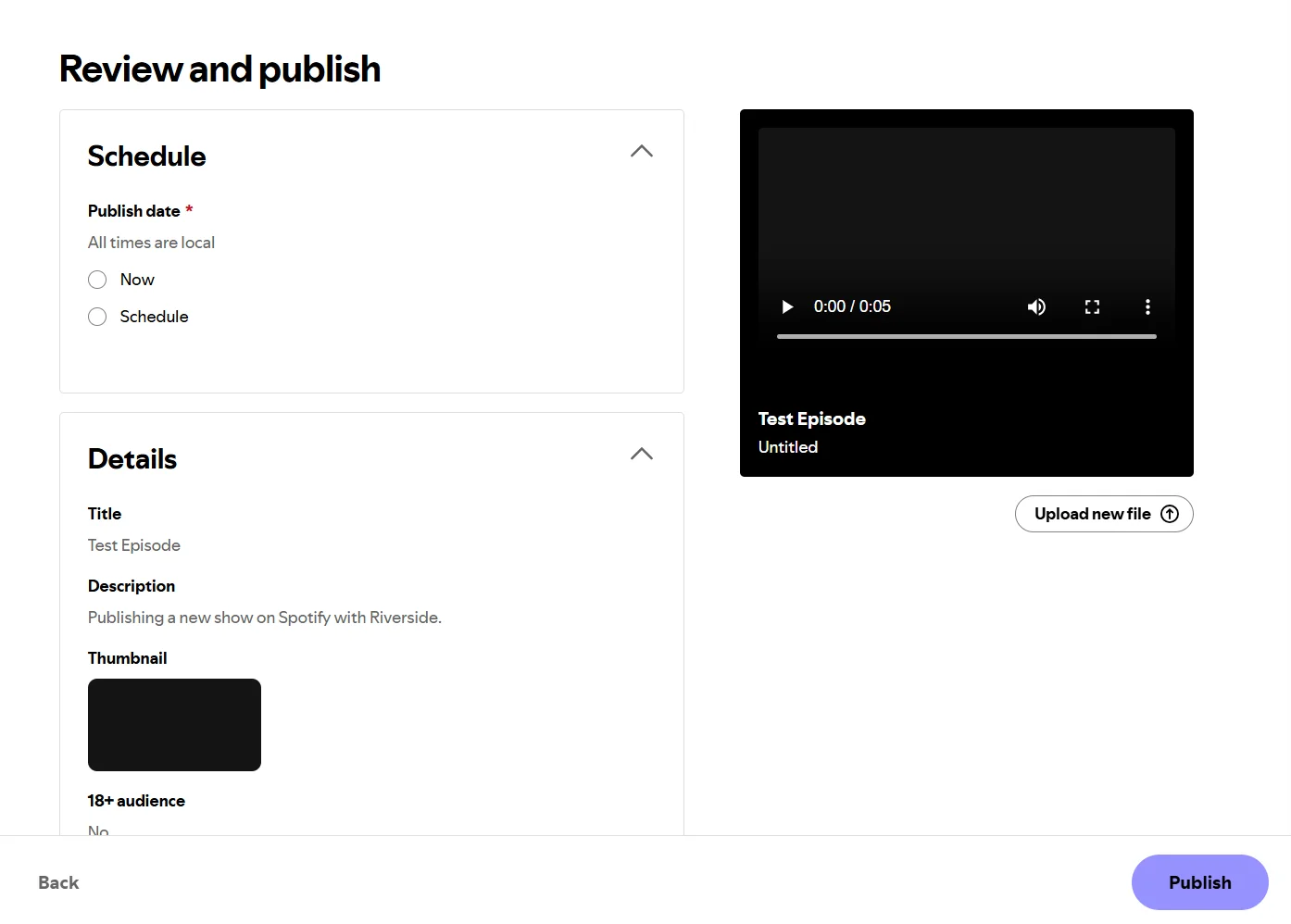
If you need more details, or if you have any doubts, you can check out our in-depth guide on how to upload a podcast to Spotify.
Should you use Anchor.fm (Now Spotify for Creators)? Pros and cons
Spotify for Creators (formerly Anchor) is a solid starting point for beginner and casual podcasters. It’s free, easy to use, and comes with everything you need to launch a show. But experienced creators may feel its limitations around monetization, copyright, and flexibility.
“User review: I use it. I'm small potatoes still, but Spotify's own advertising has gotten me thousands of impressions and a few dozen new followers, far more than any other single source, and I didn't have to do anything. — David S. Filippi, MD, host of the Significant podcast”
Here is my final verdict on its pros and cons to help you decide:
Pros
- Free unlimited hosting: Just like Anchor was, Spotify for Creators is really free. You can upload as many episodes as you want without worrying about storage limits or third-party hosting services. It's the perfect way to experiment with a podcast idea without committing any money to it.
- Wide distribution network: With 700 million active users across 184 markets, Spotify allows your podcasts to reach a massive audience.
- Seamless integration with Riverside: Spotify is integrated with Riverside. You have professional-grade audio and video recording for your podcasts just one click away.
- Advanced analytics: Spotify’s analytics are detailed and quite in-depth (if you trust their accuracy). You’ll get data about episode performance, listener demographics, and behavior, and more.
- User-friendly interface: The platform is intuitive and easy to navigate, making it ideal for beginners and casual users.
Cons
- Unfavorable monetization: The steep 50% ad revenue split makes it very difficult for new podcasters to earn a meaningful income. Also, certain monetization options may not be available in all regions.
- Limited control: You are building your brand on rented land. If you host your show on Spotify, you are subject to its terms of service and content policies, including future changes.
- Basic customization: The interface is very streamlined, which may be a good thing for some people. But it lacks the advanced customization features that some podcasters desire.
- Poor customer support: Many users report that getting help from a real person can be very hard, leaving you to rely on help articles and community forums.
- Very Spotify-centric: Although you can distribute your podcasts on other platforms, doing so is not automatic, and the platform is optimized for Spotify listeners.
Comparison with other podcasting platforms
Other platforms lack a streamlined workflow that Spotify for Creators offers through it’s Riverside integration. But other podcasting platforms like Buzzsprout or Apple Podcasts Connect also have their merits.
So how does Spotify compare to these other popular podcasting platforms? Let’s have a quick look.
Riverside hosting

If you want to bring the whole “all-in-one platform” to the next level, Riverside has recently launched its own podcast hosting service (currently in beta).
If you’re using Riverside as your go-to software for recording and editing, using it as a host will streamline your workflows even further. You can publish directly from your export list without having to manually upload the files.
While Riverside hosting isn’t free like Spotify, creators using Riverside’s Standard or Pro plan won’t pay anything extra as this feature is included.
Here are a few key characteristics of Riverside hosting that differentiate it from Spotify for Creators:
- Spotify offers a fragmented workflow: record with Riverside, then host and distribute for free on their platform. Riverside offers one-click publishing straight from exports all while maintaining the highest quality from start to finish.
- Despite their limitations, Spotify offers monetization options. Riverside doesn’t.
Podbean
If Spotify (formerly Anchor) is an excellent launchpad for brand-new podcasters, Podbean is often the next step for podcasters who are ready to invest in their show. For a monthly fee, you’ll get more flexibility, reliable analytics, stronger video distribution, and less taxing monetization options.
Here’s what differentiates Podbean from Spotify for Creators:
- Spotify's video podcasts are confined to its own platform, while Podbean supports distribution to YouTube and other directories.
- Spotify for Creators is 100% free with unlimited hosting. Podbean starts at $9/month for audio hosting and $29/month for video hosting.
- Podbean provides IAB-certified analytics, the industry standard trusted by most advertisers.
- Podbean offers more flexible monetization options like live show monetization and a built-in patron system. Plus, you get a better ad revenue share as Podbean only takes a 30% cut.
Buzzsprout
If you’ve got even more money to invest and you’re serious about your podcast, Buzzsprout is what you’ll likely upgrade to. It gives you more customization and optimization options for your show, as well as full control of distribution, monetization, and promotion.
Buzzsprout is better for creators seeking a universal platform to create and manage their RSS feed, regardless of where they plan to distribute it.
- Buzzsprout’s built-in monetization has less strict eligibility rules and only takes a 15% revenue cut on automated ads. You can also add affiliate links or use third-party tools.
- Buzzsprout gives you a universal RSS feed and full directory control, including manual submissions to Apple Podcasts, YouTube, and more.
- You can only load audio podcasts on Buzzsprout, so if you’re looking for video episodes, you’ll need to host elsewhere (like YouTube or Riverside).
- Paid plans start at $19/month for just 4 hours, but most creators will need the steeper $39/month tier for more content.
- Buzzsprout’s podcast website building options are among the best in the market, and come with extra features like SEO tools and subscription banners.
Final thoughts
Anchor (now Spotify for Creators) is one of the best platforms to start your podcasting journey. It’s free, easy to use, and beginner-friendly. It also has the largest audience out there. Plus, it’s fully integrated with Riverside to ensure best-in-class quality for recording and editing your content.
FAQs on Anchor podcast platform (now Spotify for Creators)
How do I access podcasts on Spotify?
Open the Spotify app on your desktop or mobile device, and click on the search icon on the top left corner of the screen. Type the name of the podcast you’re looking for, and then click on the cover art to find the episode list. Select the episode you want to listen to, and click play.
How do I claim my podcast on Spotify?
You can claim your podcast with these steps:
- Log into your Spotify for Creators account, click on your avatar icon on the top right corner of the screen.
- Select “Add a new podcast” then “I already have a podcast.”
- On the new page, paste in your podcast's RSS feed URL.
Spotify will then send a verification code to the email address associated with your RSS feed. Copy the 8-digit code from that email and paste it in the submit form. After verifying, you can access your podcast’s analytics and manage its profile on Spotify for Creators.
You can learn more in our full guide on how to upload a podcast on Spotify.
How effective is Anchor by Spotify for podcast creation and editing?
Anchor by Spotify was a basic but effective platform for podcast creation and editing. It was especially appreciated by beginners since it was affordable, streamlined, and easy-to-use.
But, these legacy tools don't exist anymore, as Spotify purchased Anchor.fm and eventually upgraded and rebranded it as Spotify for Creators. Spotify is now integrated with Riverside, so you can get access to studio-quality recording and fast, precise editing all in one place.
What are the latest features of Spotify for Podcasters?
In 2023, Spotify for Podcasters (now called Spotify for Creators) expanded its toolset by adding new features focused on video and monetization.
On the video end, this includes:
- Supporting video podcasts Spotify exclusive podcasts
- The ability to upload short-form video clips
- Custom thumbnails to improve discovery
For monetization, they started the Spotify Partner Program. This allows eligible creators to earn revenue from ads and from Spotify Premium subscribers who watch their video content.
Is Spotify good for creators?
Yes, Spotify for Creators is a great entry-level platform, especially for beginners and hobbyists. Since it’s free and allows creators to tap into Spotify's massive audience, it’s the ideal place to launch a new podcast.
However, if you want to grow your show or build a business out of it, its limitations can quickly become frustrating. The 50% ad revenue split is high, and analytics are not IAB-certified, so many advertisers won’t trust them.
Does Spotify for Creators cost anything?
No, hosting your podcast on Spotify for Creators is completely free. You get unlimited storage and bandwidth with no monthly fees. However, Spotify takes a very high cut of revenues from automated ads (50%), and maintains a very broad license to use, distribute, and create derivative works from your content.
Want to read more on podcast hosting platforms? Check out our other reviews:














.webp)
.webp)
-Need-to-Know-About-Podcast-Hosting-Sites.png)


